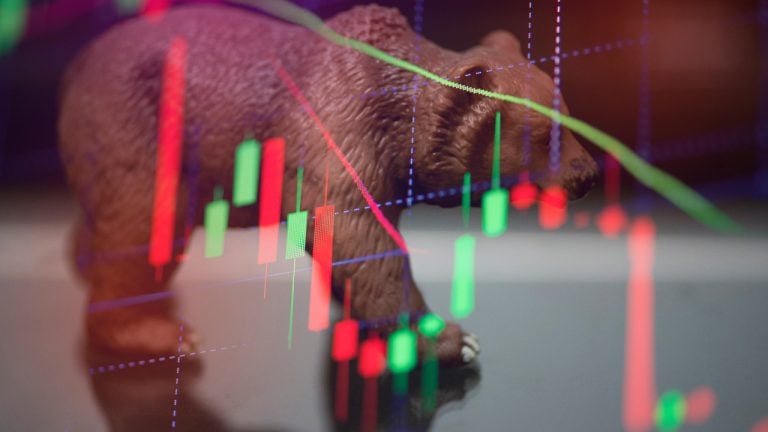
Bitcoin traders are truly “spooked,” and sentiment crashes harder than BTC price as the shake-up from last week’s losses continues.
Bitcoin (BTC) starts a new week with traders licking their wounds after a 10% snap crash.
BTC price action is struggling to recover from a manic end to the days prior to the weekend, and the fear is palpable going into what could turn out to be an equally volatile few days.
With $26,000 so far forming the focus for the markets, theories are brewing over where Bitcoin might head next.
Multiple factors are set to converge to provide some influence — United States macro data prints are firing up again, while the Federal Reserve will deliver key commentary on the economy at the annual Jackson Hole Economic Symposium.
Within Bitcoin, meanwhile, short-term holders now face increasing unrealized losses, and on-chain transactions in loss are setting multi-year highs.
Sentiment is back on the floor, but is the fear really justified?
Cointelegraph takes a look at these topics and more ahead of what promises to be an interest week for crypto markets.
BTC order book "ghost town" after OI obliterated
While many expected volatility to kick in around the Aug. 20 weekly close, Bitcoin in the end produced something of a non-event, data from Cointelegraph Markets Pro and TradingView shows, with $26,300 capping the extent of its upside.
A subsequent comedown took the market back to the $26,000 mark, where it traded at the time of writing.

After a week of mayhem, traders and analysts alike remained highly cautious on the outlook, with sources referencing various triggers for new downside.
“Traders still spooked, expecting more downside,” trading suite Decentrader wrote in an X update on Aug. 21.
Decentrader noted that traders were positioned short across exchanges after a major open interest wipeout during last week’s drop.
“Funding rates continue to be negative,” it added.
Maartunn, a contributor to on-chain analytics platform CryptoQuant, described Binance order book liquidity as a “ghost town.”
“This will open the door for volatility, in case you've missed it,” he suggested, alongside a chart showing liquidity and whale order volumes from monitoring resource Material Indicators.

Maartunn nonetheless reasoned that upside could come as a result, given historical precedent.
“In the entire history of Bitcoin, there were 11 times when Open Interest had a similar decline as three days ago. Among these eleven, eight led to increased prices, whereas three did not,” part of a separate analysis stated.
As Cointelegraph reported, overall long and short liquidations reached levels comparable to the aftermath of the November 2022 FTX implosion.
Bitcoin traders weigh "consolidation scenario"
The quiet weekend gave some traders pause for thought. Bitcoin, they argued, might now open the door to a new phase of rangebound trading.
“Bitcoin fell off back into the previous range. Most likely outcome for next week is to keep trading the range imo,” popular trader CrypNuevo told X subscribers.
“I would like to see a false move to the downside to $25700-$25800 on Monday and then a relief bounce the rest of the week till mid-range $27k.”

Fellow trader Crypto Tony eyed a reclaim of the weekend’s $26,300 local top as a call to action.
“Until then i am sitting on hands waiting for Bitcoin next move,” he concluded.
Maartunn likewise acknowledged that a consolidation period for BTC/USD was “not unlikely.”
Another possible scenario for #Bitcoin is a period of consolidation.
— Maartunn (@JA_Maartun) August 20, 2023
This is not unlikely, as we have witnessed such consolidation multiple times in the past following significant market movements.https://t.co/pfl62msjJm pic.twitter.com/1jeRb6eJfL
On weekly timeframes, trader Skew outlined upside, downside and consolidation scenarios all being possible.
“Consolidation scenario is chopping between $25K & $30K ~ long term range,” he confirmed alongside an illustrative chart.

Key timing for Powell's Jackson Hole speech
While last week was quiet in terms of United States macroeconomic data releases, the coming five days promises a key change of tempo.
U.S. jobless claims will hit on Aug. 24, with home sales and other data preceding them.
“Volatility is officially back,” financial commentary resource The Kobeissi Letter summarized to X subscribers.
Key Events This Week:
— The Kobeissi Letter (@KobeissiLetter) August 20, 2023
1. Existing Home Sales data - Tuesday
2. US Services PMI data - Wednesday
3. New Home Sales data - Wednesday
4. Core Durable Goods data - Thursday
5. Initial Jobless Claims - Thursday
6. Fed Chair Powell Speaks - Friday
Volatility is officially back.
Traders and analysts, however, have their eyes mostly set on Jerome Powell, Chair of the Federal Reserve, who will take to the stage at the annual Jackson Hole Economic Symposium on Aug. 25.
Jackson Hole is a classic venue for market volatility, and given the current climate, this year’s event should be no exception.
“The Fed's annual Jackson Hole meeting is more important than ever this week,” Kobeissi added.
Powell will be joined by speakers including Christine Lagarde, Chair of the European Central Bank (ECB).
With both the Nasdaq and S&P 500 joining crypto in a week of losses, historical patterns could still turn the tables as Jackson Hole traditionally provides risk-on relief.
More often than not, stocks rise the week after Jackson Hole
— Markets & Mayhem (@Mayhem4Markets) August 20, 2023
Will this year follow the pattern, or will it be one of the outlier years with a sell-off? pic.twitter.com/QPST4p9HUs
Popular trader and analyst Miles Johal was also hopeful, noting that unlike stocks and Bitcoin, U.S. dollar strength faced an uphill struggle.
“SPX - Uptrend, at support and oversold. BTC - Uptrend, at support and oversold. DXY - Downtrend, at resistance and overbought. US10Y - Double top pattern, at resistance and overbought,” he explained to X subscribers.
“Lining up very clearly. $BTC and Equities bias is vertical up after the correction is over.”

Kobeissi meanwhile added that the equity put/call ratio had reached its highest since the start of 2023, suggesting a volatile move would soon hit.
“Are markets bracing for a major pullback or is another short squeeze about to begin?” it queried.
On-chain losses mount as speculators feel the pressure
It will come as little surprise that Bitcoin’s 11% drop engendered a considerable shake-up in on-chain profitability metrics.
Among these is the adjusted Spent Output Profit Ratio (aSOPR), which tracks aggregate profitability of all transactions, excluding those with an age of one hour or less.
This “price sold versus price paid” ratio is now back below 1, the barrier between profit and loss, to hit its lowest levels in five months, per data from on-chain analytics firm Glassnode.

Glassnode also revealed a three-year high in the seven-day average number of unspent transaction outputs (UXTOs) in loss.

At that time, BTC/USD was seeing another August retracement — one that was nonetheless short lived, with September seeing its final visit to $10,000 before launching to new all-time highs later in 2020.
Speculators were on the receiving end of most of the pain this time around, with Bitcoin currently trading below the cost basis, or realized price, of short-term holders (STHs) — entities holding BTC for under 155 days.

Familiar fear
Could Bitcoin in fact not be as weak as the market makes out?
Related: Bitcoin on the way to 'bearadise?' $20K is back as a BTC price target
Sentiment data suggests a knee-jerk reaction as the defining response to recent BTC price action — and the dust may be yet to settle.
According to the Crypto Fear & Greed Index, the average crypto investor is more scared now than at any time since the Silicon Valley Bank (SVB) collapse in March.
At just 38/100, “fear” is firmly in command as the new week begins, with Fear & Greed dropping 16 points over the past seven days.

Among those calling for a more balanced take on the status quo, meanwhile, is trading team Stockmoney Lizards. BTC price performance regularly encounters the kind of drawback seen last week, it argued, making this month nothing new.
“Bitcoin sell off and everyone is yelling 10k,” it summarized at the weekend, commenting on a comparative chart of price action in the current halving cycle versus its previous one.
“The history of BTC is lined with such sell offs and the market will recover from it as it did in the past.”

Popular trader and analyst Rekt Capital went into further detail, noting several 20%+ drawdowns in 2023 alone on BTC/USD.
All #BTC pullbacks in 2023:
— Rekt Capital (@rektcapital) August 17, 2023
• Early February -12%
• Late February -22%
• March -9%
• April to June -20%
• July to August -12%$BTC #Crypto #Bitcoin pic.twitter.com/4pmBXPY0fp
Data from monitoring resource CoinGlass puts August 2023 losses at -10.8% as of Aug. 21.

This article does not contain investment advice or recommendations. Every investment and trading move involves risk, and readers should conduct their own research when making a decision.

































